Nicholas U. Mayall Telescope
The Nicholas U. Mayall Telescope, also known as the Mayall 4-meter Telescope, is a four-meter (158 inches) reflector telescope located at the Kitt Peak National Observatory in Arizona and named after Nicholas U. Mayall. It saw first light on February 27, 1973, and was the second-largest telescope in the world at that time.[2] Initial observers included David Crawford, Nicholas Mayall, and Arthur Hoag.[2] It was dedicated on June 20, 1973 after Mayall's retirement as director.[2] The mirror has an f/2.7 hyperboloidal shape. It is made from a two-foot (61 cm (24 in)) thick fused quartz disk that is supported in an advanced-design mirror cell. The prime focus has a field of view six times larger than that of the Hale reflector. It is host to the Dark Energy Spectroscopic Instrument. The identical Victor M. Blanco Telescope was later built at Cerro Tololo Inter-American Observatory, in Chile.[3]
| Alternative names | Mayall 4-meter Telescope |
|---|---|
| Part of | Kitt Peak National Observatory |
| Location(s) | Arizona |
| Coordinates | 31°57′48″N 111°36′00″W |
| Organization | National Optical Astronomy Observatory |
| Altitude | 2,120 m (6,960 ft) |
| Built | 1968 |
| First light | February 27, 1973[1] |
| Discovered | Methane ice on Pluto |
| Telescope style | reflecting telescope Ritchey–Chrétien telescope |
| Diameter | 4 m (13 ft 1 in) |
| Collecting area | 11.4 m2 (123 sq ft) |
| Website | www |
 Location of Nicholas U. Mayall Telescope | |
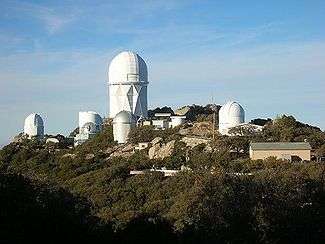
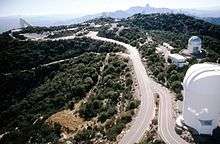
The telescope was dedicated in the summer of 1973, at which time it was the second largest telescope by aperture in the world.[4] The telescope was named after Mayall who was the director of Kitt Peak National Observatory (of the United States) for over a decade.[4]
The telescope primary mirror is designed to function as the first element in a Ritchey-Chretien optical design.[5] The telescope was originally designed with three focal point options: the prime focus, a wide-field R/C focus, and a coude focus.[6]
- Planning & Construction
In 1961, after work had moved forward on other telescopes, Mayall proposed an even larger 150-inch mirror telescope for Kitt Peak.[7] Site construction began in 1968, and by 1971 the mirror was delivered to the site.[8] The mirror was made by Owens-Illinois.[8]
The mirror was made of fused quartz, valued for its low coefficient of thermal expansion, and the blank was ground at the Kitt Peak optical lab.[7]
Instruments
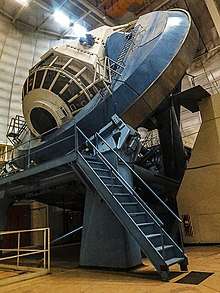
Examples of instruments over its lifetime include various spectrographs, Cryogenic Camera, the Phoenix spectrometer, and the DLIRIM.[6]
The KNPO Mosaic camera was installed in 1998, and was designed for the prime focus.[9] This camera had eight 2048 × 4096 CCD sensors.[9] This lead to another camera Mosaic II for the CTIO 4-m telescope in the southern hemisphere.[9]
- Mosaic3
Mosaic3 was an imaging camera for the Mayall telescope.[10] This prime focus camera was used for a 3-band survey in support of the upcoming DESI instrument.[10]
- Fourier Transform Spectrograph
One instrument used with telescope was the Fourier Transform Spectrograph.[11] The FTS was used between 1975 and 1995, creating an archive of recorded spectra.[12] It was noted for collecting infrared spectrum before the advent of infrared imaging arrays.[12]
Over the time of its operation 10,000 spectra were taken of 800 different astronomical targets, and these were made available in the SpArc data archive in the early 21st century.[12]
- DESI
In late 2019 the DESI instruments was nearing completion, an instrument designed to help understand dark matter.[13] Dark Matter was theorized by Fritz Zwicky in 1933, based on calculations of star motion that seemed to require more mass — dark matter.[13] Zwicky used then largest telescope in the world, the 100-inch (254 cm) Hooker telescope in California for this research.[14]
DESI has five thousand fiber optic sensors, each one being robotically targetable at the focal plane.[13][15] Planned to examine the nature of millions of galaxies and quasars, the instrument has been a decade in construction and features contributions from hundreds of researchers.[13]
The telescope control software was also upgraded in the 2010s to prepare for DESI.[16]
In October 2019, DESI achieved its first light test and in March was commissioned. Full operations were expected by the end of 2020.[17]
Discoveries & Observations
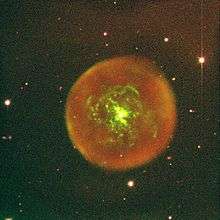
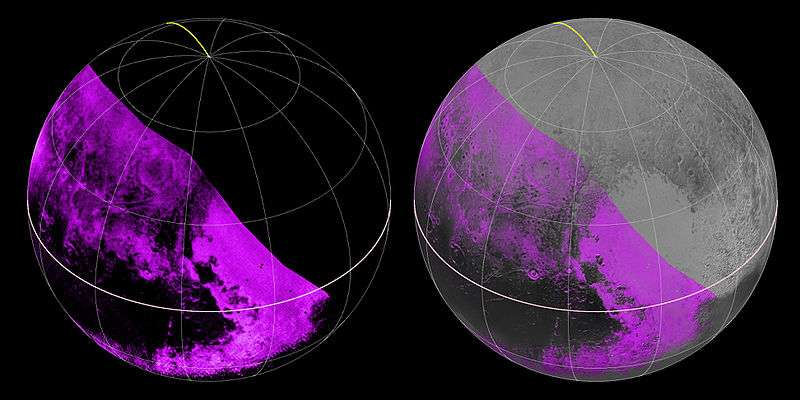
In 1976 the Mayall Telescope was used to discover methane ice on planet Pluto.[18]
The FTS on Mayall was also used to study methane in the outer solar system in the 1980s.[19] The study included observation of monodeutered methane on Titan, a moon of Saturn noted for its thick atmosphere.[19] The Mayall was also one of several large telescopes that was part of a study of the Andromeda galaxy.[20] The observations helped understand the history of that Galaxy, which turn helps understand Earth's galaxy, the Milky Way.[20]
Contemporaries on commissioning
The Mayall was the second-largest telescope when inaugurated, between the Hale (5 m) and Shane (3 m).
Largest telescopes 1973:
| # | Name / Observatory |
Image | Aperture | Altitude | First Light |
Special advocate |
|---|---|---|---|---|---|---|
| 1 | Hale Telescope Palomar Obs. |
200 inch 508 cm |
1713 m (5620 ft) |
1949 | George Ellery Hale | |
| 2 | Mayall Telescope Kitt Peak National Obs. |
158 inch 401 cm |
2120 m (6955 ft) |
1973 | Nicholas Mayall | |
| 3 | Shane Telescope Lick Observatory |
120 inch 305 cm |
1283 m (4209 ft) |
1959 | Nicholas Mayall C. Donald Shane | |
| 4 | Harlan J. Smith Telescope McDonald Observatory |
107 in 270 cm |
2070 m (6791 ft) |
1968 | Harlan J. Smith |
Here is the dedication of the telescope with its namesake at the eyepiece:
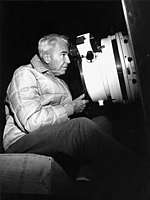 Mayall on March 2, 1973 viewing through the telescope to be named in his honor. |
Observation examples
See also
- List of astronomical observatories
- List of largest optical reflecting telescopes
- List of largest optical telescopes in the 20th century
- List of the largest optical telescopes in the contiguous United States
References
- Lindsley, Dave; Edmondson, Frank; Kiani, Shiva (2008), Celebrating 50 years; Kitt Peak National Observatory; Milestones at Kitt Peak (PDF)
- Robert D. Chapman; William M. Sinton. "Telescope". AccessScience@McGraw-Hill. doi:10.1036/1097-8542.681600. Cite journal requires
|journal=(help) - "Kitt Peak opens up its 158‐inch telescope", Physics Today (letter), 26 (5): 19, 2008-12-29, doi:10.1063/1.3128047
- "1972ailt.conf...39H Page 39". Bibcode:1972ailt.conf...39H. Cite journal requires
|journal=(help) - "Mayall 4-Meter Telescope: Instruments". www.noao.edu. Retrieved 2019-11-09.
- Leverington, David (2017). Observatories and Telescopes of Modern Times. Cambridge University Press. ISBN 9780521899932.
- "Mayall 4-Meter Telescope: History". www.noao.edu. Retrieved 2019-11-07.
- Dey, Arjun; Valdes, Francisco (2014-03-01). "The Delivered Image Quality with the MOSAIC Cameras at the Kitt Peak 4 m Mayall and Cerro Tololo 4 m Blanco Telescopes". Publications of the Astronomical Society of the Pacific. 126 (937): 296. doi:10.1086/675808. ISSN 1538-3873.
- Dey, Arjun; Rabinowitz, David; Karcher, Armin; Bebek, Chris; Baltay, Charles; Sprayberry, David; Valdes, Frank; Stupak, Bob; Donaldson, John; Emmet, Will; Hurteau, Tom (2016-08-00). "Mosaic3: a red-sensitive upgrade for the prime focus camera at the Mayall 4m telescope". Ground-based and Airborne Instrumentation for Astronomy VI. 9908: 99082C. Bibcode:2016SPIE.9908E..2CD. doi:10.1117/12.2231488. Check date values in:
|date=(help) - "Mayall 4-Meter Telescope: Instruments". www.noao.edu. Retrieved 2019-11-07.
- Pilachowski, C. A.; Hinkle, K. H.; Young, M. D.; Dennis, H. B.; Gopu, A.; Henschel, R.; Hayashi, S. (January 2017). "An Archive of Spectra from the Mayall Fourier Transform Spectrometer at Kitt Peak". Publications of the Astronomical Society of the Pacific. 129 (972): 024006. arXiv:1610.02535. doi:10.1088/1538-3873/129/972/024006. ISSN 1538-3873.
- "Kitt Peak Instrument To Study Dark Energy Begins Final Tests". KJZZ. 2019-10-31. Retrieved 2019-11-07.
- expert, Carolyn Collins Petersen Carolyn Collins Petersen is an astronomy; team, the author of seven books on space science She previously worked on a Hubble Space Telescope instrument. "Mount Wilson Observatory: Where Astronomy History Was Made". ThoughtCo. Retrieved 2019-11-07.
- Jr, Glenn Roberts. "DESI opens its 5000 eyes". symmetry magazine. Retrieved 2019-11-07.
- Abareshi, Behzad; Marshall, Robert; Gott, Shelby; Sprayberry, David; Cantarutti, Rolando; Joyce, Dick; Williams, Doug; Probst, Ronald; Reetz, Kristin; Paat, Anthony; Butler, Karen; Soto, Christian; Dey, Arjun; Summers, David (2016). "A new telescope control software for the Mayall 4-meter telescope". Software and Cyberinfrastructure for Astronomy Iv. 9913: 99131O. Bibcode:2016SPIE.9913E..1OA. doi:10.1117/12.2233087.
- Lincoln, Don. "Super New Telescope Opens Its Eyes For The First Time". Forbes. Retrieved 2019-11-09.
- Leverington, David (2003-05-29). Babylon to Voyager and Beyond: A History of Planetary Astronomy. Cambridge University Press. ISBN 9780521808408.
- "1988ApJ...329..951D Page 951". Bibcode:1988ApJ...329..951D. Cite journal requires
|journal=(help) - "Two Ancient Migration Events In The Andromeda Galaxy - SpaceRef". spaceref.com. Retrieved 2019-11-09.
External links

- The Mayall 4-meter Telescope - official site.
- Scale model of 4 meter
- Active Optics Upgrade